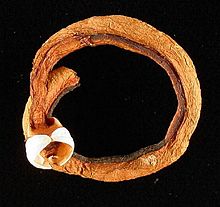Shipworms
| Shipworm | |
|---|---|
 |
|
| This dried specimen of Teredo navalis was extracted from the wood and the calcareous tunnel that originally surrounded it and curled into a circle artificially. The two valves of the shell are the white structures at the anterior end; they are used to dig the tunnel in the wood. | |
| Scientific classification | |
| Kingdom: | Animalia |
| Phylum: | Mollusca |
| Class: | Bivalvia (or Pelecypoda) |
| Order: | Myoida |
| Family: |
Teredinidae Rafinesque, 1815 |
| Genera | |
|
See text |
|
See text
The shipworms are marine bivalve molluscs in the family Teredinidae: a group of saltwater clams with long, soft, naked bodies. They are notorious for boring into (and commonly eventually destroying) wood that is immersed in sea water, including such structures as wooden piers, docks and ships; they drill passages by means of a pair of very small shells borne at one end, with which they rasp their way through. Sometimes called "termites of the sea", they also are known as "Teredo worms" or simply Teredo, from the Greek language "τερηδων", via Latin. Eventually biologists adopted the common name Teredo as the name for the best-known genus.
Removed from its burrow, the fully grown teredo ranges from several centimetres to about a metre in length, depending on the species. The body is cylindrical, slender, naked and superficially , meaning "worm-shaped". In spite of their slender, worm-like forms shipworms nonetheless possess the characteristic morphology of bivalves. The ctinidia lie mainly within the branchial siphon, through which the animal pumps the water that passes over the gills.
The two siphons are very long and protrude from the posterior end of the animal. Where they leave the end of the main part of the body the siphons pass between a pair of calcareous plates called pallets. If the animal is alarmed, it withdraws the siphons and the pallets protectively block the opening of the tunnel.
The pallets are not to be confused with the two valves of the main shell, which are at the anterior end of the animal. Because they are the organs that the animal applies to boring its tunnel, they generally are located at the tunnel's end. They are borne on the slightly thickened, muscular anterior end of the cylindrical body and they are roughly triangular in shape and markedly concave on their interior surfaces. The outer surfaces are convex and in most species are deeply sculpted into sharp grinding surfaces with which the animals bore their way through the wood or similar medium in which they live and feed. The valves of shipworms are separated and the aperture of the mantle lies between them. The small "foot" (corresponding to the foot of a clam) can protrude through the aperture.
...
Wikipedia
